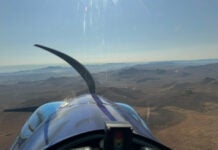I love flying single-seat airplanes. In fact, for pure, unadulterated aeronautical fun, it is hard to beat a single-seater. Since they are generally smaller, they have lower moments of inertia, making them quicker maneuvering in all axes. Smaller generally also means lighter—which means better performance. And, well, you know what they say…”The best thing about a single-seat airplane is the quality of the social experience!” Yeah, I know it’s fun to give rides to others. But for introverted engineering types like myself, it’s nice to get away where it’s “just you” for a while.
There are so many good single-seat airplanes that I love, and that I have gotten to fly while writing for KITPLANES, that it would be hard to pick a favorite; I really have liked them all! So then, what I want to write about this month might seem a little odd, because, well…single-seat airplanes don’t always make a lot of sense when you start looking at the numbers. Yet it’s important to look at all aspects of a major purchase (or build) such as an airplane, so in the interest of full disclosure and opening people’s eyes, it is important to recognize that in choosing a single-seater over, say, a two-seater, you are probably not going to save very much money—and certainly not half.
When contemplating an airplane build, we generally recommend that people have a look at the “rule of thirds.” The finished cost of a homebuilt will generally consist of a third for the airframe kit (or materials), a third for propulsion (engine and prop), and a third for avionics and finishing materials (like interior and paint). If a person asks me how much I think it will cost to build a specific airplane, I ask how much the kit costs and tell them to triple it. They’ll probably end up within 10 or 15%, if they build according to averages.
The problem, when it comes to single-seaters, is that while they are smaller, requiring fewer raw materials so the kit cost is less, this doesn’t have a tremendous effect on the finished price. Let’s say that you are deciding between two airplanes that are powered by a Rotax 912 engine and equipped similarly. Yes, you can hang a Rotax on the nose of many single-seat designs, and you can also hang it on the nose of many two-seaters. Performance will be plenty with the two-seater and rocket-like in the one-holer. If you decide that both of them are going to be VFR machines with a simple interior, then the costs of avionics and interior are going to be close to the same. The engine and prop are also the same. That accounts for two thirds of the finished airplane, no matter which one you build.
Let’s say that you are able to find the single-seat kit for half the price of the two-seater. That means that the finished single-seat airplane will be just 5/6 the cost of one that carries a passenger—not half. So if we stick arbitrary numbers on these things, it’s going to cost us $60,000 for the two-seater, and $50,000 for the single-place. In airplane terms, that’s not a lot of difference; both are significant portions of the average person’s net worth. It would be really nice if you could build the single for half of the two-place—$30,000—but the truth is, that isn’t going to happen if you compare apples to apples. It’s a sad truth, but true nonetheless.
Now, anyone who knows me, or has read my writing, knows that I dearly love my RV-3. I’ve also got a warm spot in my heart for the Panther, the Merlin SPA, the Cassutt, the Hummelbird, the Mk26 Spitfire…in fact, there are almost no single-seaters that I don’t like. And if I wanted one, I’d build one without much hesitation. But I wouldn’t try to justify the expense because the single-seater was that much cheaper. Instead, I’d be honest and simply admit that the quality of the flying experience in the single-seater is worth more (pound for pound) than the two-seater.
Economics is a hard science and, quite frankly, if you can make the economics of any light airplane work out, you are a better manipulator of numbers than I am. We choose to aviate because we love it—not because it makes for a good dollars-and-cents argument. Very few people save money by flying—but sometimes flying makes an activity (like a daily commute in a good-weather part of the country) practical, where doing it by car would simply be unacceptable. But aviating in general is hard to justify when it comes to pure economics.
Given that argument, I’d say that if you really want to fly a single-seater and enjoy the freedom that comes with a more nimble and compact machine, then don’t try to justify it as a way to save money! Revel in the experience and launch alone into the unbridled blue, leave the ledger behind, and go for it. The experience is priceless.















I’m afraid I completely disagree. Single-seaters are lighter and therefore don’t require the same size of engine as a two-seater, as in Rotaxes 912 v 582.
I have carefully costed out both and since my family shows no interest at all in flying I have gone the UK’s SSDR route (single seat de-regulated) and have saved myself thousands. I am aiming to build my Fisher 505 with a second-hand but rebuilt 582 and instruments from a stripped old Xair for about £15,000. It’ll be more, no doubt, but not much more.
A Zenith 750 or Skyranger comes in nearer to £50,000, a C42 much more. Van’s? Well, I don’t have enough years left.